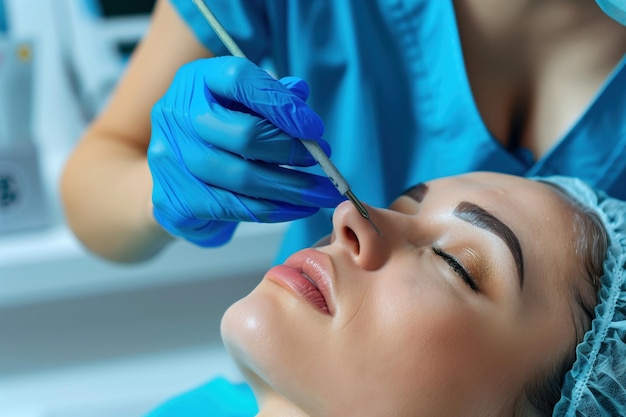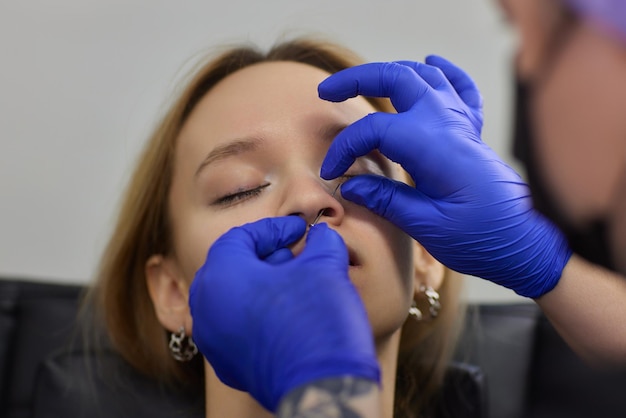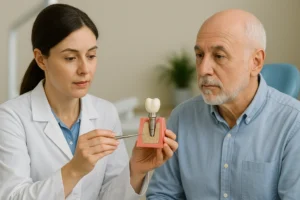A sinus lift, also known as sinus augmentation, is a surgical procedure designed to enhance the bone in your upper jaw, particularly in the area of your molars and premolars. The primary objective is to raise the sinus floor and create additional bone to accommodate a dental implant. This procedure becomes necessary when there is insufficient bone height in the upper jaw, or when the sinuses are positioned too close to the jaw, making it challenging to place implants securely.
The sinus lift procedure is a pivotal advancement in dental surgery, enabling patients with bone loss or naturally close-set sinuses to still qualify for dental implants. By raising the sinus floor and augmenting bone volume, oral surgeons can create a stable foundation for implants, which are crucial for supporting dental prosthetics. This procedure not only facilitates dental restoration but also plays a significant role in improving the patient’s overall oral function and aesthetics.
How Prestige Oral and Facial Surgery Supports Patients Through Sinus Lift Procedures
At Prestige Oral and Facial Surgery Center, our team specializes in advanced surgical procedures like sinus lifts that are crucial for patients preparing to receive dental implants. Our board-certified oral surgeons perform this treatment with the highest precision, using state-of-the-art technology and guided imaging to ensure accurate planning and execution. Whether bone loss has occurred due to long-term tooth absence or anatomical limitations are preventing implant placement, our goal is to create a safe, stable foundation for lasting dental restorations.
What sets Prestige Oral apart is the comprehensive care we provide before, during, and after your sinus lift. We start with advanced 3D imaging (CBCT scans) to assess bone structure and sinus positioning, then walk each patient through the entire process—from selecting the right bone grafting material to monitoring post-operative healing. Our patients benefit not just from our surgical expertise, but also from a compassionate team committed to ensuring your comfort, safety, and long-term oral health.
For patients anxious about surgery, we offer sedation options and a clear step-by-step recovery plan tailored to your specific needs. Once the sinus lift is complete and healing is confirmed, we seamlessly transition you into the dental implant phase, restoring both function and aesthetics. With a reputation for excellence in implantology and maxillofacial surgery, Prestige Oral and Facial Surgery Center is your trusted partner in achieving a confident, secure smile—starting with a successful sinus lift.
To learn more about the science and standards behind sinus augmentation, visit the American Academy of Periodontology’s official resource:
https://www.perio.org/consumer/sinus-augmentation
Why Might You Need a Sinus Lift?

There are several reasons why you might need a sinus lift before getting dental implants:
- Bone Loss: Tooth loss can lead to significant bone loss in the jaw over time. When teeth are absent, the bone that once supported them begins to resorb or shrink, leading to reduced bone density. If enough bone is lost, a sinus lift may become essential to rebuild the bone structure and provide a solid base for the implant.
- Sinus Position: In certain cases, the anatomical position of the sinuses may naturally be too close to the upper jaw, leaving inadequate space for an implant. This proximity can hinder the implant placement, necessitating a sinus lift to adjust the sinus floor and create the needed room for the dental implant.
- Periodontal Disease: Chronic periodontal disease can lead to significant bone loss around the teeth, which may eventually affect the jawbone. This condition not only compromises dental health but also the structural integrity of the jaw, making a sinus lift a crucial intervention before implant placement.
- Anatomical Considerations: The natural shape and size of your sinus cavity can vary widely among individuals. For some, these anatomical variations may not allow for the straightforward placement of dental implants, making additional bone augmentation through a sinus lift necessary to ensure successful outcomes.
Preparing for a Sinus Lift
Before undergoing a sinus lift, your dental specialist will conduct a thorough examination to ensure you’re a suitable candidate for the procedure. This typically includes:
- X-rays: These imaging tests are crucial for studying the jaw and sinuses, providing a detailed view of the bone structure and sinus proximity.
- CT Scans: Advanced CT scans are used to precisely measure the height and width of your existing bone and evaluate the health and positioning of your sinuses. This information is vital for planning the surgery accurately.
- Medical History Review: A comprehensive review of your medical history is conducted to assess your overall health and to identify any conditions that might affect the surgery or recovery process. This step ensures that you are a good candidate for the procedure and that potential risks are minimized.
Bone Graft Material
Bone grafting material plays a critical role in a sinus lift, as it is used to add volume to the upper jaw. This material can be sourced from various origins:
- Autogenous Bone: Harvested from your own body, typically from another bone site. This option reduces the risk of rejection and promotes faster integration with the existing bone.
- Allogenic Bone: Sourced from a deceased human donor, this option is thoroughly screened and processed to ensure safety and compatibility.
- Xenograft: Bone taken from animals, commonly cows, which is processed to be biocompatible with human tissue, offering an alternative when autogenous or allogenic sources are not viable.
- Synthetic Materials: Man-made products that mimic the properties of natural bone, providing a non-biological option that reduces the risk of disease transmission.
Your dentist will discuss these options with you to determine which material best suits your specific situation and needs, considering factors such as healing time and potential for bone integration.
The Sinus Lift Procedure

The sinus lift procedure is typically performed by an oral surgeon or a periodontist, both of whom have specialized training in this type of surgery. Here’s a step-by-step guide to what you can expect:
Step 1: Anesthesia
To ensure comfort during the surgery, local anesthesia is administered to numb the area, allowing you to remain awake but free of pain. For those who are particularly anxious about the procedure, sedation options are available to help you relax and remain comfortable throughout.
Step 2: Incision
The surgeon will make a precise incision in the gum tissue where the back teeth used to be located. This incision allows access to the underlying bone, setting the stage for the subsequent steps of the procedure.
Step 3: Opening the Bone
A small, oval-shaped window is carefully cut into the bone to expose the sinus membrane. This step requires precision to avoid damaging the membrane while creating the necessary access for the bone graft.
Step 4: Lifting the Membrane
The sinus membrane is gently and meticulously pushed upward to create the required space for the bone graft. This step is crucial as it sets the foundation for the bone augmentation process.
Step 5: Placing the Bone Graft
The selected graft material is packed into the newly created space, effectively elevating the sinus floor and adding the necessary bone height to support future dental implants. This step is critical for ensuring the long-term success and stability of the implant.
Step 6: Closing the Incision
The incision is carefully stitched closed, marking the end of the surgical procedure. The healing process begins immediately, with the body’s natural mechanisms working to integrate the graft material with the existing bone.
Recovery and Healing
Recovery from a sinus lift surgery can take several months, and understanding the healing process is essential for optimal results. Here’s what to expect during the recovery phase:
Immediate Post-Op Care
- Avoid Blowing Your Nose: It’s crucial to avoid blowing your nose in the days following the surgery, as this can dislodge the bone graft material or stitches, potentially compromising the healing process.
- Manage Swelling: Swelling is a common post-operative response. Using ice packs intermittently can help reduce swelling and alleviate discomfort.
- Follow Prescriptions: Taking prescribed antibiotics and pain relievers as directed is essential to prevent infection and manage post-surgical discomfort effectively.
Long-Term Recovery
Bone integration is a gradual process that can take 4 to 9 months, depending on individual healing rates, the type of graft material used, and overall health. During this period, the new bone forms and fuses with your existing jawbone, creating a strong foundation capable of supporting a dental implant. Regular follow-up appointments will allow your oral surgeon to monitor the graft site, ensure proper healing, and determine the appropriate time to proceed with implant placement.
Some key recommendations during this period include:
- Maintain Good Oral Hygiene: While avoiding direct contact with the surgical site, keep your mouth clean with gentle rinsing and follow any specific oral care instructions provided by your dental team.
- Avoid Smoking: Smoking can significantly impair healing and increase the risk of graft failure. If you smoke, consider this a good opportunity to quit or at least reduce usage during the healing period.
- Stick to a Soft Diet: For the first few weeks post-surgery, avoid hard or crunchy foods that could disturb the graft site. Gradually reintroduce firmer foods as advised by your surgeon.
When Will You Get Your Dental Implant?
Once your surgeon confirms that the grafted bone has successfully integrated, typically between 6 to 9 months post-op, you’ll be ready for the next phase: dental implant placement. This secondary procedure is usually straightforward, thanks to the strong and stable foundation created by the sinus lift.
After implant placement, a final restoration—such as a crown or bridge—is custom-designed and affixed, fully restoring both function and appearance. With proper care, these restorations can last for many years, often decades.
Trust Your Smile to Experts
If you’ve been told that you’re not a candidate for dental implants due to bone loss or sinus proximity, a sinus lift may be the life-changing solution you need. At Prestige Oral and Facial Surgery Center, we take pride in guiding our patients every step of the way—from evaluation and planning to surgery and recovery—with expert care and personalized attention.
Whether you’re exploring your options or ready to move forward with a sinus lift, our team is here to help. Schedule a consultation today and take the first step toward a stronger foundation—and a more confident smile.



